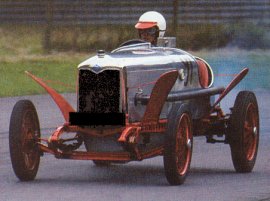
Models such as this 1922 "Sandracer"
were affectionately dubbed “Redwing”
- so named because of the characteristic scheme
of polished alloy body shell with red “wing”
style mudguards...
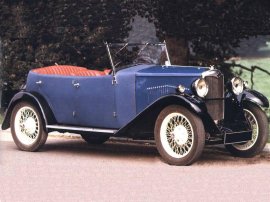
Racing success for the “Nine” came
quickly, it taking out third place at the Brooklands
Double Twelve hour race in 1930, and second place
in the Irish Grand Prix the same year....
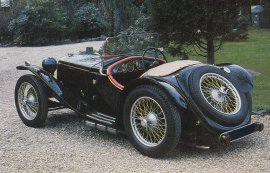
The “Imp” was built on a short wheel
base chassis and was arguably the best of the bunch.
Fitted with a (for the time) very elegant body,
the Imp featured lovely flared mudguards and afforded
blistering 75mph performance...
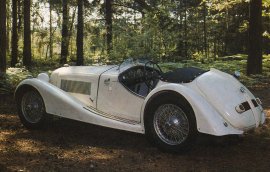
To compete with BMW’s wonderful 328 model,
Riley made their Sprite available with a 6 cylinder
1498cc engine...
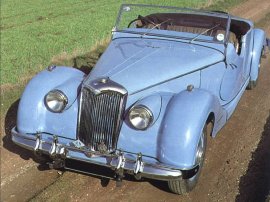
The Riley "RM Series sported a twin-cam engine
with hemispherical combustion chamber, and used
a timber-framed body and a fabric covered roof.
Fully hydraulic brakes replaced the hydro-mechanical
ones in 1952...
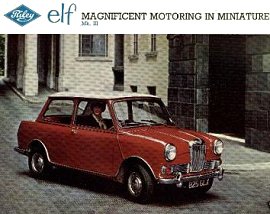
Riley were to linger on as a marque for Nuffield,
and in turn BMC, until the late 1960’s, but
nothing with any sporting pretence was graced with
the Riley badge during this time... |
With thanks to Geoffrey Luck.
It should come as no surprise, particularly
if you have read other articles in the “Lost Marques”
feature of this site that Riley did not start out manufacturing
cars. In fact the automobile was simply a progression,
the company at first being involved in the weaving
trade and later manufacturing bicycles.
The first Riley
car was built in 1898, and was considered at the time
very innovative even at this early time in the evolution
of the automobile. How could this be?; well the 1898
car featured the first mechanically operated inlet valve,
by 1919 Riley had introduced detachable wire spoke wheels,
and in 1919 they introduced adjustable front seats and steering column.
The “Riley” wheel was soon gaining a stellar
reputation, so much so that Rolls-Royce took out a license
to manufacture it, along with at least eight other manufacturers.
Indeed it is widely rumoured that the Riley family seriously
considered abandoning car manufacture to concentrate
on wheel manufacture only!
Whatever the case, the Riley Company certainly had
a very innovative design department. In fact the company
was prone to announce new models without ever having
the capacity to begin manufacture. Most today agree
that the first Riley of note was the 1919 “Eleven”,
although given the array of body styles available it
is a car somewhat hard to detail.
Fitted with a 1498cc
4 cylinder engine, it was originally available as a
two seater sports car, then a four-seater sports car,
and by 1924 as a short-chassis “Redwing”
- so named because of the characteristic scheme of polished
alloy body shell with red “wing” style mudguards.
By 1926 Riley unveiled the new “Nine” at
the London Motor Show, the name being based on the RAC rating for the engine (ie: the taxable horsepower).
The “Nine”
was quite a sporty little car, thanks largely to the
lively new engine that had been designed by Percy Riley
himself. The 1087cc engine was, for the time, technically
unequalled, featuring twin high camshafts (one each
side of the block) operating short pushrods to the opposed
overhead valves, which were in part-spherical combustion
chambers.
This turned out to be a very effective “breathing”
layout, one that Riley would retain in their engine
design for the next 30 years! The engine developed 32bhp at 5000rpm, but the engine
put enormous stress on its two main bearing crankshaft. When Percy had rectified this, the engine was good for
an extremely healthy 50bhp. Early versions of the “Nine”
were fitted with either a saloon or tourer body, but
in 1927 a sports version named after the famous (Surrey)
UK racing track was released.
The “Brooklands”
was designed with the help of Parry Thomas and Reid
Railton, both famous motor sport identities in the of
the 1920’s and 1930’s. The shell for the
Brooklands was manufactured by a company called “Thomson
and Taylor”, and it was no coincidence that their
factory was located inside the track itself!
To improve handling the design featured a very low
slung body, so much so that a driver could reach out
and touch the road without having to lift his backside
out of the seat (given of course that he was of Scottish
extraction and afflicted with short arms and long pockets). Racing success for the “Nine” came quickly,
it taking out third place at the Brooklands Double Twelve
Hour Race in 1930, and second place in the Irish Grand
Prix the same year.
1930 was an important year for Riley for not only winning
these prestigious races, but for the release of the
super sports version of the Nine dubbed the “Ulster
Brooklands”. Featuring a balanced engine fitted
with extra carburettors, this new model ensured race
success, most notably in the 1932 Tourist Trophy race
and a class win at the 1935 Le Mans.
Different specifications
quite naturally meant that there were different price
points for the new Nine, and Riley choose to give each
model a suitable moniker to help identify each. At the
lower end was the 1932 £298“Gamecock”,
while a fixed head version was called the “Lincock”. The last of the Nine’s was built in 1934; the
“Imp” was built on a short wheel base chassis
and was arguably the best of the bunch. Fitted with
a (for the time) very elegant body, the Imp featured
lovely flared mudguards and afforded blistering 75mph
performance for just £325 – unfortunately
only 75 would be manufactured.
For racing purposes, the
engineers were allegedly able to obtain an output of
183bhp at 7400rpm from the Riley’s three-bearing
engine – something we are unable to confirm but
suspect the supercharger was turned to maximum boost! Less well known but worthy of mention was the Riley
in-line 6 cylinder engine. Originally released in 1928,
the engine only found its way into a handful of sports
type Riley’s, although it would grace the then
famous ERA racing cars from 1934 onward.
The “Six”
was almost identical to the four in design, which included
three main bearings and, coincidentally, was first built
with a 1633cc capacity. This engine was to find its
way into the “MPH” model, a car similar
to the “Imp” except in price, the latter
contributing to the very small number (12) manufactured. It remains one of the great paradoxes of times past
that Victor Riley never believed his engine was capable
of race tuning. One need only look at Raymond Mays’
famous “White Riley” and the ERA’s
that were to evolve from it to see just how well suited
the Riley engines were to supercharging and race tuning!
The engines were built in 1.1, 1.5 and 2.0 litre versions,
the most powerful boasting a huge 300bhp output. Privateers
loved the 6 cylinder Riley engine, and with a carburettor
fitted per cylinder the engine became extremely successful
– most notably when in the hands of Freddie Dixon. In 1934 Riley announced their new 1496cc four cylinder
engine dubbed the “12/4”. The engine was
basically a re-design of that used in the “Nine”
and was developed principally by Hugh Rose. The engine
originally used a chain-driven cam, but gear drive was
incorporated shortly after release.
It first found a
home in the “Kestrel” saloon, but was soon
being fitted to the 1935 “Sprite” model.
This latter model looked very similar to the “MPH”,
but obviously differed in that the new 4 cylinder engine
was fitted instead of the 6 cylinder unit. The purchaser
of a Sprite could specify either the traditional “Riley”
grille or “Fencer’s Mask”. But more importantly for Riley was the arrival of BMW’s
wonderful 328 model. Quickly realizing it needed to
be competitive with the German competitor, Riley made
their Sprite available with the 6 cylinder engine and
even released some race specials known as “TT
Sprites”.
Unfortunately for Riley they were to
run into financial difficulty – most blamed the
diversity of their model line-up – but whatever
was the problem the directors were forced to call in
the receivers in 1938. Lord Nuffield took over the concern
in the Autumn of the same year, and in turn sold it
for considerable personal loss to his Nuffield organization
where the marque joined the likes of Morris, Wolseley
and MG.
As the company sank into bankruptcy, Percy Riley made one last throw to save it. He put two Nine engines together to make a V8 intended to power a grand saloon. This was not a rumour - at least one came to Australia and was owned by Jack Downing, whose workshop in Brisbane's Wooloongabba was a mecca for lovers of great cars. The Downings also had a Riley Imp and an AC among other exotica. Downing helped Geoffrey Luck rebuild his 1930 model Nine with an Australian built roadster body in 1950. He was a fantastic engineer who could make anything in his workshop. He turned up a set of wheel nuts for Luck's Riley - with left hand threads for the wheels on the passenger side!
Ultimately Percy's attempts to save the marque failed, although Riley did linger on as a marque for Nuffield, and
in turn BMC, until the late 1960’s, but nothing
with any sporting pretence was graced with the Riley
badge during this time. Knowing the technical brilliance
of the engines, they naturally found their way into
most Healey cars built between 1946 and 1954.
Recommended Reading: Riley - As Old As The Industry, As Modern As The Hour - Death By Diversity |



